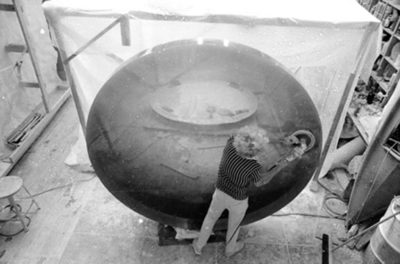
Sheila, ready to help with queries for the Conservation Collection
When the Getty Conservation Institute moved into its original headquarters in 1985, our offices included space for a library to support our investigative work. It included resources on conservation, historic preservation, and applied science and technology. With our move to the Getty Center in 1996, these materials were absorbed into the holdings and physical space of the Getty Research Institute’s Research Library.
While the Conservation Institute no longer houses this collection, we’ve continued to be involved in its development by collecting materials in areas that support our work and the work of the conservation profession worldwide. Approximately 2,000 titles are added each year in both digital and print formats. By the latest calculations, the collection numbers almost 50,000 titles.
The core of the Conservation Collection, as this group of materials it is now known, consists of current or 20th-century publications related to the preservation and conservation of material cultural heritage. Beyond traditional books and journals, the collection also includes case studies, treatment reports, conference proceedings, government documents, theses, and dissertations.
The depth of the collection, which goes beyond the specific research interests of the Getty, is a major draw for the scholars we host each year. It also serves Getty staff, the local conservation community, architects and historic preservationists, and a significant number of visitors from across the globe.

Inside the book Seeley Brothers, manufacturers of Averill Paint, ready for use (New York: Seeley Brothers, ca. 1886). ID No. 2870-944

Page from a scrapbook containing textile samples, patterns, and clippings, chiefly related to hand weaving, compiled by Dorothy P. Harvey of Meredith, New Hampshire, 1935–50. ID No. 2010.M.76
One of the most interesting aspects of working with the collection is to observe how it is used. It’s hard to imagine the purpose 30-year-old newsletters could have for a conservation professional today. Yet recently a museum conservator requested just such materials, saying, “I’m not interested in the answers they were finding [in 1985], I’m interested in the questions they were asking.”
Some items even maintain their relevance even over centuries. Servants’ manuals from the 18th and 19th centuries, for example, provide information that is still useful for conservators caring for furniture, rugs, silver, and other objects that decorated the estates of the British aristocracy.
Professionals in conservation and historic preservation undertake significant research prior to beginning a treatment or course of action. For example, an architect working to restore a historic house needs to understand the carpentry, interior decoration, even the plumbing that was typical of the period. A collection of historic trade catalogues, which can be found in the Conservation Collection, can supply the answers to those kinds of questions.

Title page from Six hundred receipts, worth their weight in gold… (available on the Internet Archive)
Conservators specializing in objects need to understand how they were made. Among the Conservation Collection’s pre-20th-century imprints are chemical recipe books with practical hints for all manner of materials and trades, which can aid conservators in this research. You can discover the fascinating scope of these materials through the digitized version available publically via the Internet Archive.
Numerous other manuals and treatises written for the benefit of artists, architects, engineers, and craftsmen can also be accessed online by searching the Research Library’s ever-expanding digital collections.
Finally, the Conservation Collection encompasses important archival holdings, which can provide a window into conservation practice as seen in the papers of William Suhr, a paintings conservator for the Frick Collection and private clients, which contain photographs and treatment notes from about 1920 to 1979.
It also provides information on artists’ materials—for example through the archive of F. Weber & Company, one of the largest manufacturers of art materials in the United States, which contains printed catalogs, sample books and brochures, technical information (including paint formulas), and correspondence dated from 1865 to 1973.
The richness of the Conservation Collection speaks to our commitment to building and making accessible a collection of library materials to further conservation research worldwide—be it scientific, practical, or theoretical—insuring that the advances of the past 30 years continue well into the future.




Comments on this post are now closed.